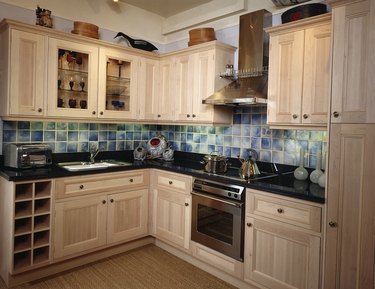
Cabinet doors are often a focus of remodeling projects. Old cabinet doors detract from the appeal of a kitchen or room. Styles and tastes change over time, and since cabinet doors take up so much visual space, they often bear the brunt of scrutiny. They are relatively inexpensive to refinish, and some techniques are more cost-effective than others. Dipping a cabinet door is not considered a simple or cost-effective way to refinish for several reasons.
Materials Required
Video of the Day
In order to dip a cabinet door, a basin filled with stain is required. A plastic sheet to prevent spills is also a necessity. Dipping tools, including a clamp and drying rack with sufficient run-off basins, are also a requirement. Due the work that goes into dipping a cabinet door, it is not the preferred method of refinishing. To complete the process will involve much more work than simply brushing on a stain or sealant.
Video of the Day
Completing the Task
The cabinet door must be dipped properly. A clamp or handle must be attached to secure the cabinet door and provide a means of lifting it into and out of the dip. A space where the clamp or handle is attached will remain and must be painted over. Add a screw to the back of the cabinet, and the door can be suspended from a rack. This option involves damaging the surface of the cabinet, however. The process of dipping the cabinets may result in additional damage and problems. While drying the stain will flow towards the bottom of the cabinet, unless it is laid horizontally and one side is dipped at a time. Again this involves a great deal of work and the results are no better than staining them by hand.
Alternatives
Refinish cabinets with a stain using a small stain brush, foam brush or spray gun. Apply the stain is even strokes, one side at a time and then set the cabinets aside to dry unstained side face down on a drying rack. Once dry, repeat the process on the other side. Staining the cabinet this way only takes a few minutes per side plus drying time and the result is an even coat that enhances the original luster of the wood. The process is cleaner and easier to perform than dipping the entire cabinet into a vat of stain. It requires less materials as well.